Snake Plant Care: How to Grow this Diehard Houseplant
Sansevierias (now Dracaenas) are popular & easy-care houseplants. Here you’ll find Snake Plant Care tips, including things good to know to keep yours growing.
Snake Plants are some of the toughest plants you can find. Whether indoors, in your garden, or on your balcony, these spiky beauties can put up with almost anything. They’re easy to grow, but you should know a few things. Keep reading for Snake Plant care tips as a houseplant – you’ll see how low maintenance they really are.
Snake Plant Traits
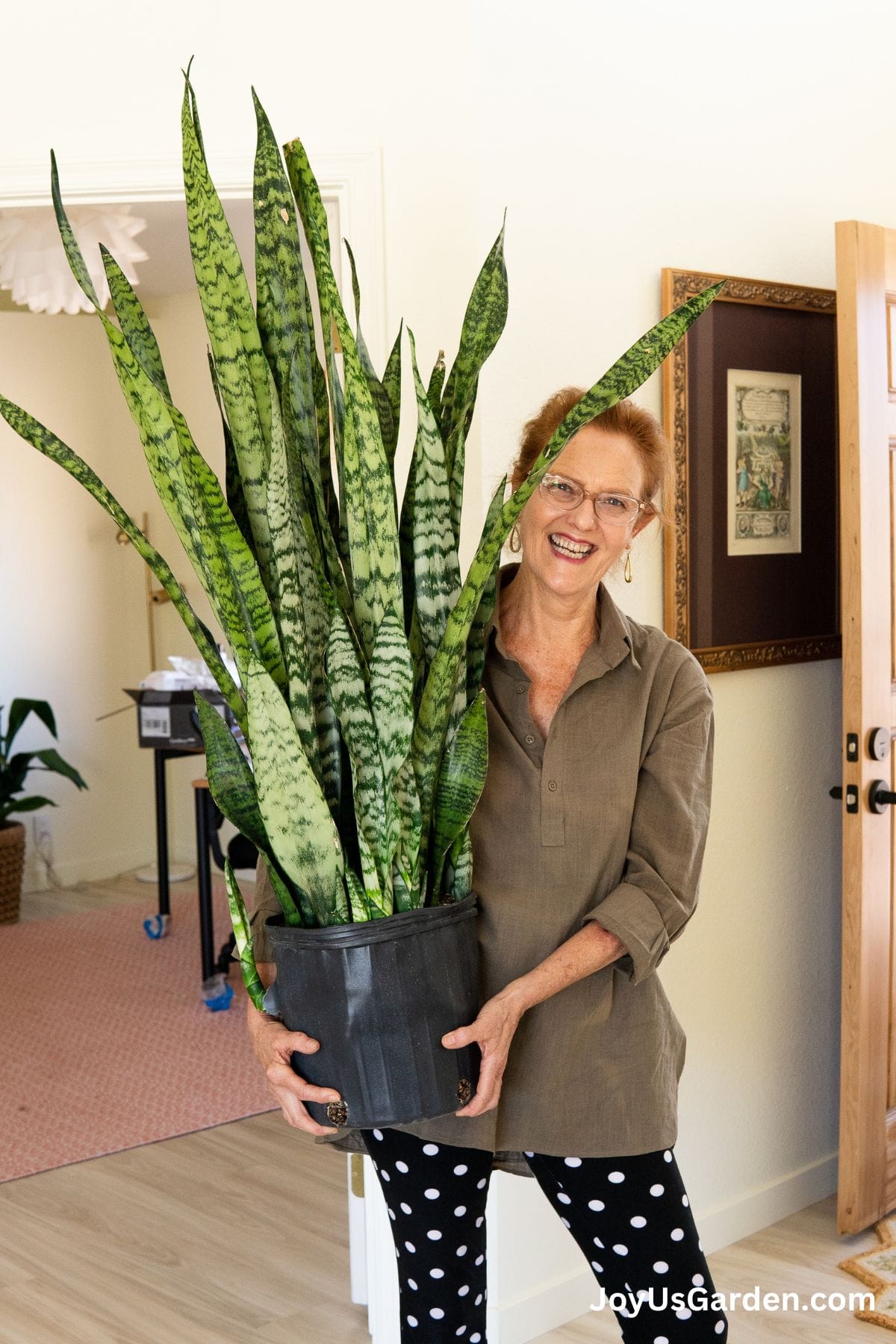
- Botanical Name: Dracaena spp & varieties (this plant has recently been reclassified from the Sansevieria genus to the Dracaena genus, but most still call them Sansevierias, so I will, too, for now).
- Common Name: Snake Plant, Mother-In-Law’s Tongue
Everyone doesn’t swoon over these plants because of their strong, bold look and tough sword-like leaves. They’re definitely not the soft, “touchy-feely” kind of plants but certainly have character and interest and present quite the striking silhouette.
Their modern, edgy feel appeals to me, along with how easy they are to care for. I now live in Tucson, Arizona, where I have them growing in my home and a couple in pots outside in the bright shade on my covered patio. The strong desert sun will fry them, but they handle the dry air like champs.
These evergreen perennials are very long-lived, unlike some houseplants. If you’re looking for your own Snake Plant, many different species and varieties are on the market, with more new ones being introduced each year.
You can find them tall or short, with round, flat, or concave leaves, and solid or variegated foliage with dark green, silver, light green, yellow, chartreuse, or white.
My personal favorites are the old standbys Dracaena trifasciata and laurentii, zeylanica, cylindrica (this is the one they braid), moonshine, futura superba, jade, gold star, and bonsal. The latter three stay small and are suited for small spaces.
Size
Snake Plants grown as houseplants average in height from 8″ to 9′. My Sansevieria Zeylanica that you see in the image above is now over 5′ tall. You can buy them in 4, 6, 8, 10, 12, and 14″ grow pots.
Growth Rate
Sansevierias are generally slow growers. They spread by underground stems called rhizomes which pop up as new growth.
In stronger natural light, they’ll grow faster and slower in lower light.
Uses
They’re used as tabletop and narrow floor plants, as well as in dish gardens and kokedama.
Snake Plant Care Guide
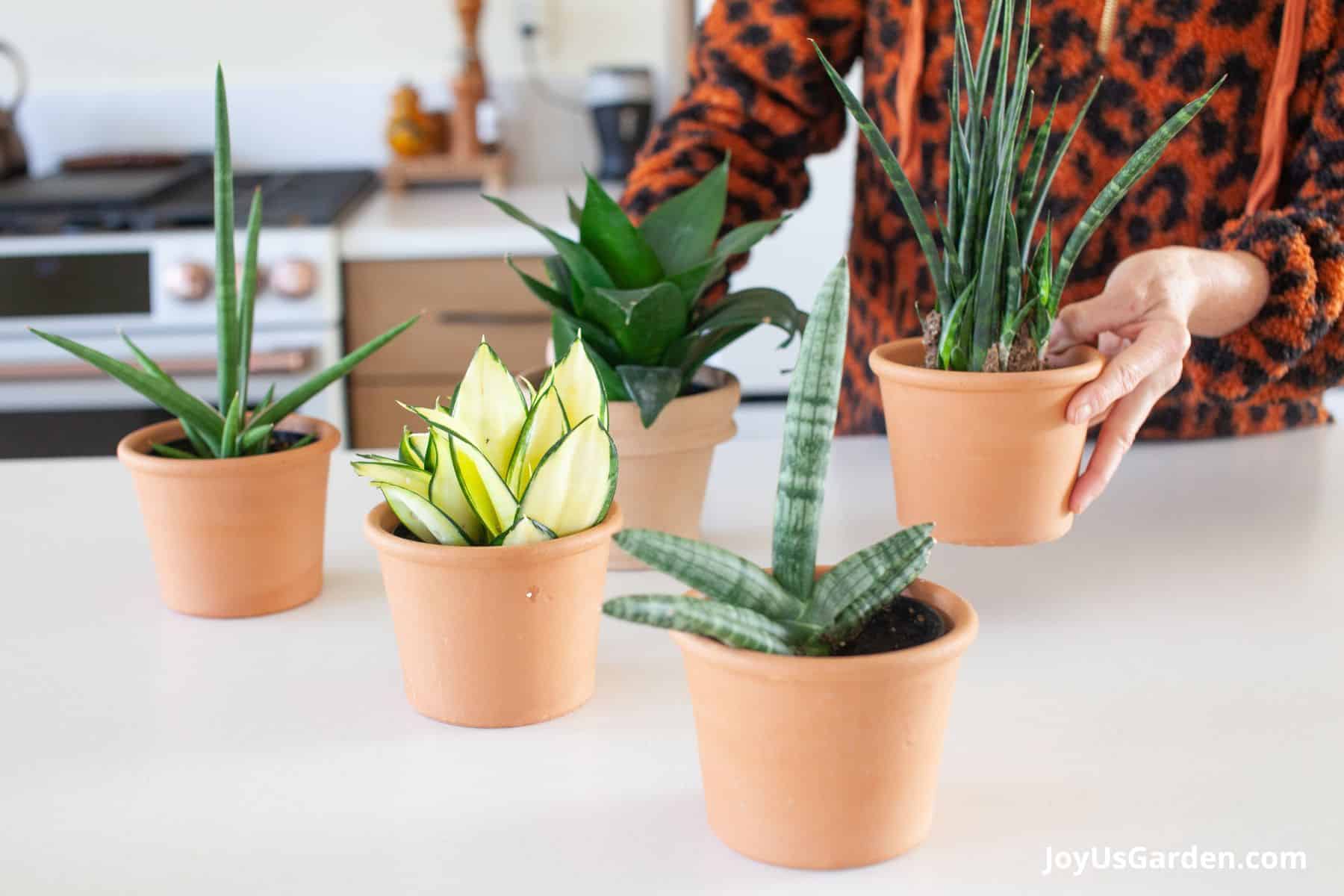
Light Requirements
Even though Sansevierias prefer medium light (about 10′ away from the west or south window), they’ll also tolerate lower and higher light levels. How versatile they are!
Just be sure to keep Snake Plants out of the direct, hot sun (not in a west or south window) because they’ll burn in a heartbeat. Indirect sunlight is their sweet spot.
Note: In lower light conditions, the darker-leafed species and varieties ( like D. trifasciata & D. hanhnii jade) do better and are the ones you should buy. Snake Plants with brighter variegations will lose color and become less patterned in low light.
Watering
Easy does it with the watering frequency – this succulent plant doesn’t need it as much as many of your other houseplants. Be careful not to overdo it because too much water often leads to root rot.
Always make sure the soil is almost completely dry before thoroughly watering again. So, if you travel or tend to ignore plants, this plant that thrives on infrequent watering is for you.
How often should I water my Snake Plants? Good question! Water your Snake Plants every two-eight weeks. Your watering schedule will vary depending on your home’s environment, type of soil mix, and pot size. For instance, new plants in small pots will need watering more often than larger, established ones.
I water my Snake Plants less often in the winter months (every five to seven weeks for those in large pots) when the temps are cooler, and the sun is less intense. This is the time of year when houseplants like to rest, and their growth slows. I water my small Snake Plants in 4″ pots every two weeks in summer and every two to three weeks in winter.
Be sure not to let water build up in the center of the leaves (where they form a cup) because this can lead to a mushy plant and ultimately rot.
You can read my Guide to Watering Indoor Plants to understand better how often to water.

Humidity Levels
These plants don’t mind our homes and offices’ sometimes dry or stale air. They do fine with average household humidity levels.
They’ll also do well in bathrooms where the humidity tends to be much higher and in my home in the desert where the levels are often low. Another versatility factor gives this houseplant the label: “diehard.”
Temperature
As I say regarding houseplants: if your house is comfortable temperature-wise for you, then your Snake Plants will do just fine. You want to avoid putting them in areas with cold or hot drafts.
They tolerate a wide range of temperatures. I have a couple of pots growing outdoors (in the shade) that do fine. We get very hot here in the desert in the summer (110F), and a handful of evenings can dip below freezing in the winter.
If yours is outdoors for the summer (make sure it’s protected from direct, full sun), know they don’t tolerate frost or snow. Get them indoors before the temperatures drop too low.
Fertilizing
Spring and summer are the best times to fertilize your plants. Early fall is fine, too, if you’re in a temperate climate.
We have a long growing season here in Tucson from mid-February through October. I fertilize with Maxsea or Sea Grow, Grow Big, and Liquid Kelp seven times during the growing season. It’s how I feed all my tropical plants. I alternate using these granular and liquid fertilizers and don’t mix them.
I feed them with a topping of worm compost and compost every two or three springs. I give them a light application of >worm compost with a light layer of compost over that. Easy does it – a 1/4 ” layer of each for a 6″ houseplant is fine.
Snake Plants aren’t that needy, and fertilizing too often will do more harm than good. Depending on your climate zone, feeding two or three times a year may do it for your indoor plants.
Whatever houseplant food you choose, don’t use more than the recommended amount because salts build up and can burn the plant’s roots. Combined with fertilizing too often, this will show up as brown spots on the leaves.
You want to avoid fertilizing any stressed houseplant, i.e., bone dry or soaking wet. I don’t fertilize houseplants in late fall and winter because it’s not their active growing season.
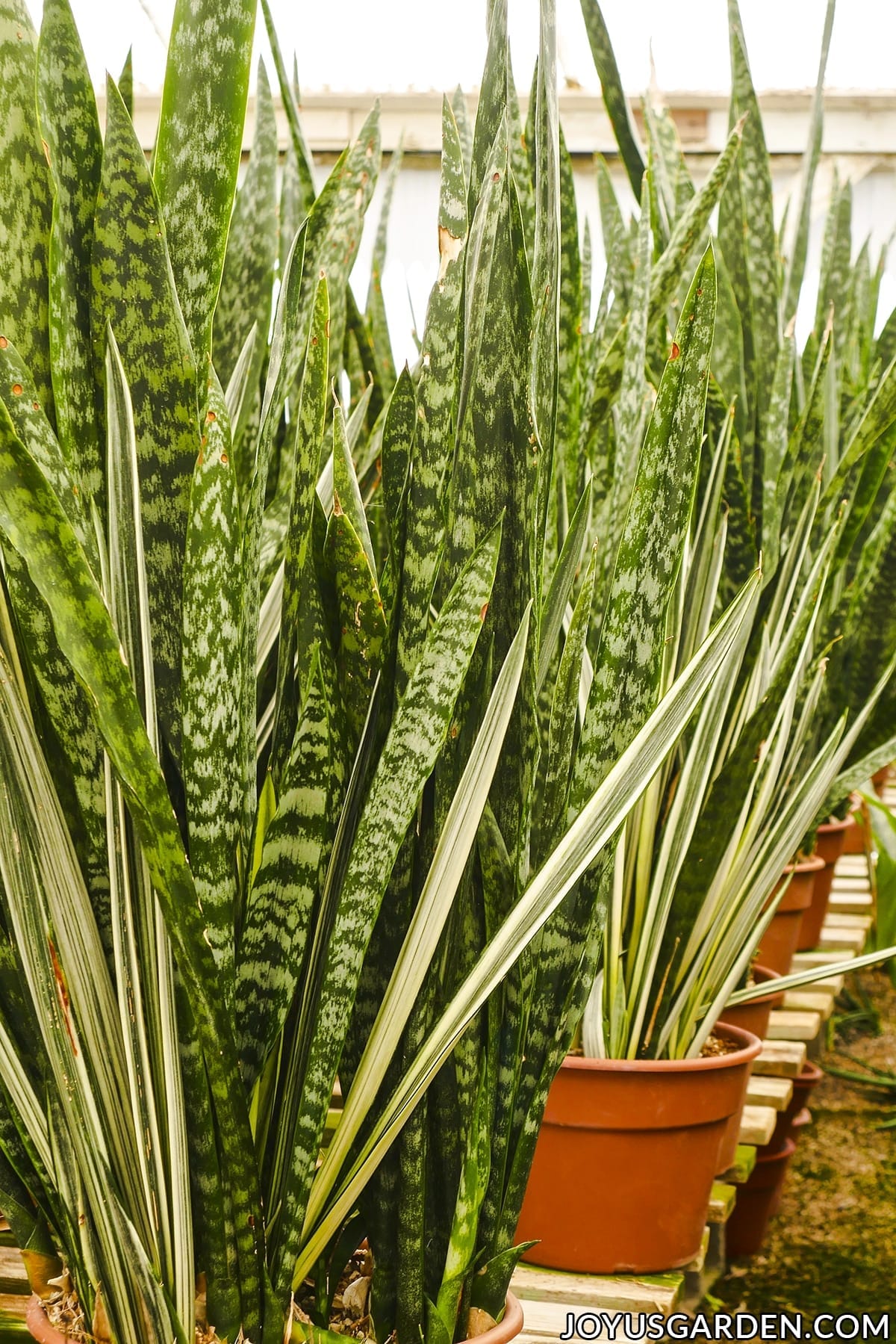
Soil
Snake Plants are easygoing with their soil requirements. Because root rot is one of the main issues that kill these plants, I’d recommend using fast and well-draining soil to help prevent this.
I use succulent and cactus mix combined with potting soil in a ratio of 1:1 for all of my Snake Plants. I make my own DIY Succulent & Cactus Mix, which I use for all my succulents indoors and outdoors.
If whatever potting mix you’re using seems too heavy, add a few handfuls of pumice or perlite to up the ante on the aeration and drainage factor. This also is beneficial if the pot only has one or two smaller-sized drain holes.
Repotting
You don’t need to rush to repot your Snake Plants. They do better when slightly pot-bound. They have tough root systems, and I’ve seen quite a few that have broken their plastic grow pots. Yes, the rhizomes and roots are that tough.
Generally, I repot mine every three to seven years at the most. If yours is in low light and not growing much, transplanting every five to ten years will probably be fine. It’ll certainly appreciate fresh soil mix at some point!
Just make sure the potting mix you use is well-draining and there’s at least one drainage hole on the bottom of the pot so the excess water can flow out.
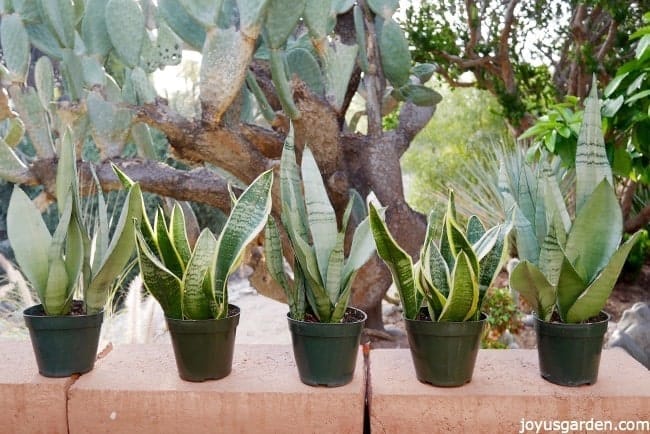
Here’s a post dedicated to repotting Snake Plants: Repotting Snake Plants: the Soil Mix to Use & How to Do it.
Pests
Snake Plants are relatively pest-resistant, but in poor conditions, they may occasionally attract mealybugs or spider mites.
If yours gets mealybugs, I’ve got you covered with this post on How to Get Rid of Mealybugs on Plants. Here you can find info on Spider Mites Control.
Regularly inspect your plant for any signs of infestation and treat accordingly using insecticidal soap, neem oil, or a DIY spray.
It’s best to take action as soon as you see any pest because they multiply like crazy. Pests can travel from houseplant to houseplant fast, so make you get them under control as soon as you see them.
Cleaning
My Snake Plants don’t get dusty too often, but I take a damp cloth and wipe off the leaves when they do. It keeps them healthy and makes them look much snazzier.
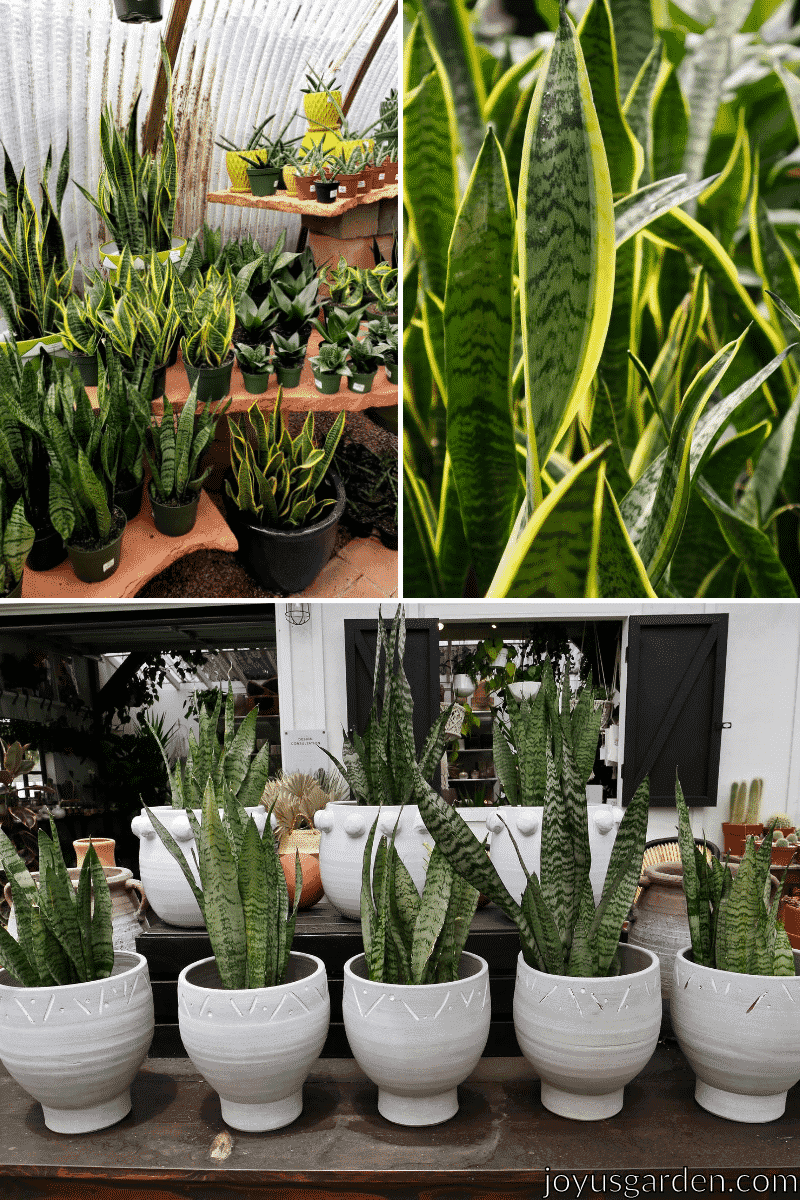
Propagating
Once you’ve got a Snake Plant, you may never need to buy another one. They’re very easy to propagate. When growing in the garden, they’ll propagate on their own as they spread by underground stems called rhizomes.
As a houseplant, division followed by leaf cuttings are the easiest ways to get new Snake Plants. You can cut off healthy leaf-cuttings and place them in a loose soil mix until they establish roots.
A faster way to propagate is by dividing or removing the offsets (pups, babies) from the mother plant. These can also be put in the same type of soil, and viola, you have a new plant!
Check out these three ways to Propagate Sansevierias and this post on Propagating Snake Plants from Leaf Cuttings.
Safe For Pets
My cats have never chewed on my Sansevieras, indoors or out. The leaves are tough, so I imagine they’re less appealing than a crunchy Spider Plant.
Snake Plants are mildly toxic to cats and dogs. I consult the ASPCA website for my info on this subject and see in what way the plant is toxic.
Most houseplants are toxic to pets in some way. Regarding this topic, do a little more research and come to your own conclusion.
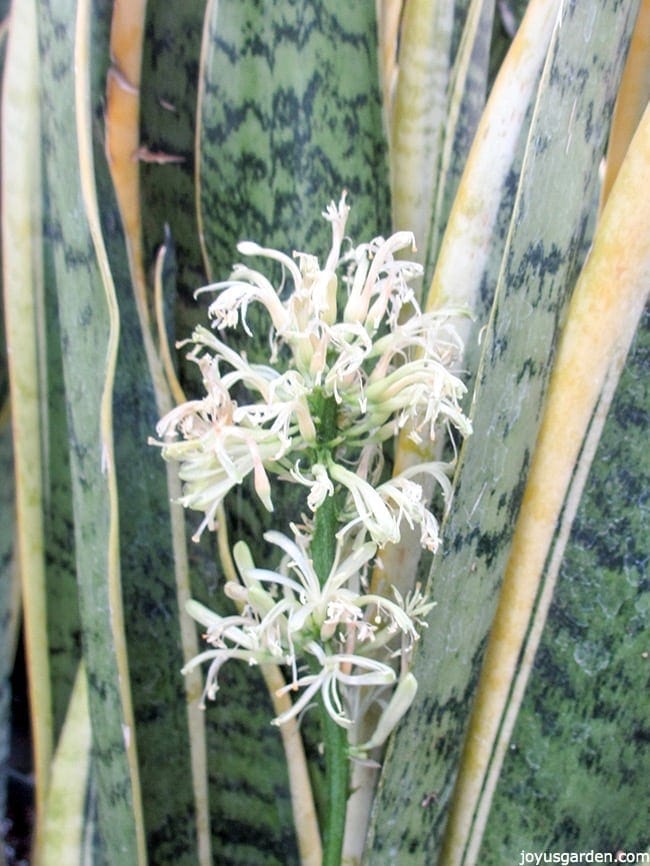
Flowers
Yes, they do but don’t hold your breath waiting for the flowers to appear when grown indoors. This occurrence is relatively infrequent and appears to be rather hit or miss. One of the varieties of Snake Plants growing in my garden in Santa Barbara would flower almost every year, but the others wouldn’t.
The flower of a Snake Plant exhibits a pale whitish to greenish hue and emits a delightful, sweet fragrance.
Snake Plant Care Video Guide
Snake Plant Care FAQs
How often do you water a Snake Plant?
Snake Plants prefer to dry out between waterings. Water them thoroughly when the soil is dry, typically every 2-6 weeks, depending on humidity, light, time of year, and pot size. Overwatering can lead to root rot.
These are versatile plants. I have them growing in my kitchen, dining room, and office.
Some will tolerate low light levels but all do best in moderate light. Those with variegation and vivid color in their foliage need bright natural light to keep it.
Yes and no. Snake Plants do best in bright indirect light. Most like a sunny location, but to be kept out of direct sunlight.
Snake plants need a well-draining soil mix. Potting soil combined with cactus and succulent mix works well. Make sure the pot has drainage holes to prevent water from building up in the soil.
An occasional yellow leaf is a natural occurrence for any plant. However, an excessive amount of yellow leaves is a sign that the plant isn’t happy. The cause could be overwatering, underwatering, too much fertilizer, too much light, and/or poor soil drainage.
Prune off any yellow leaves at the base to keep the plant looking good.
Snake plants can grow outdoors year-round in mild climates.
If yours grows indoors and you want it to spend the summer outdoors, that’s fine. Just make sure it’s out of direct sunlight and protected from excess rainfall.
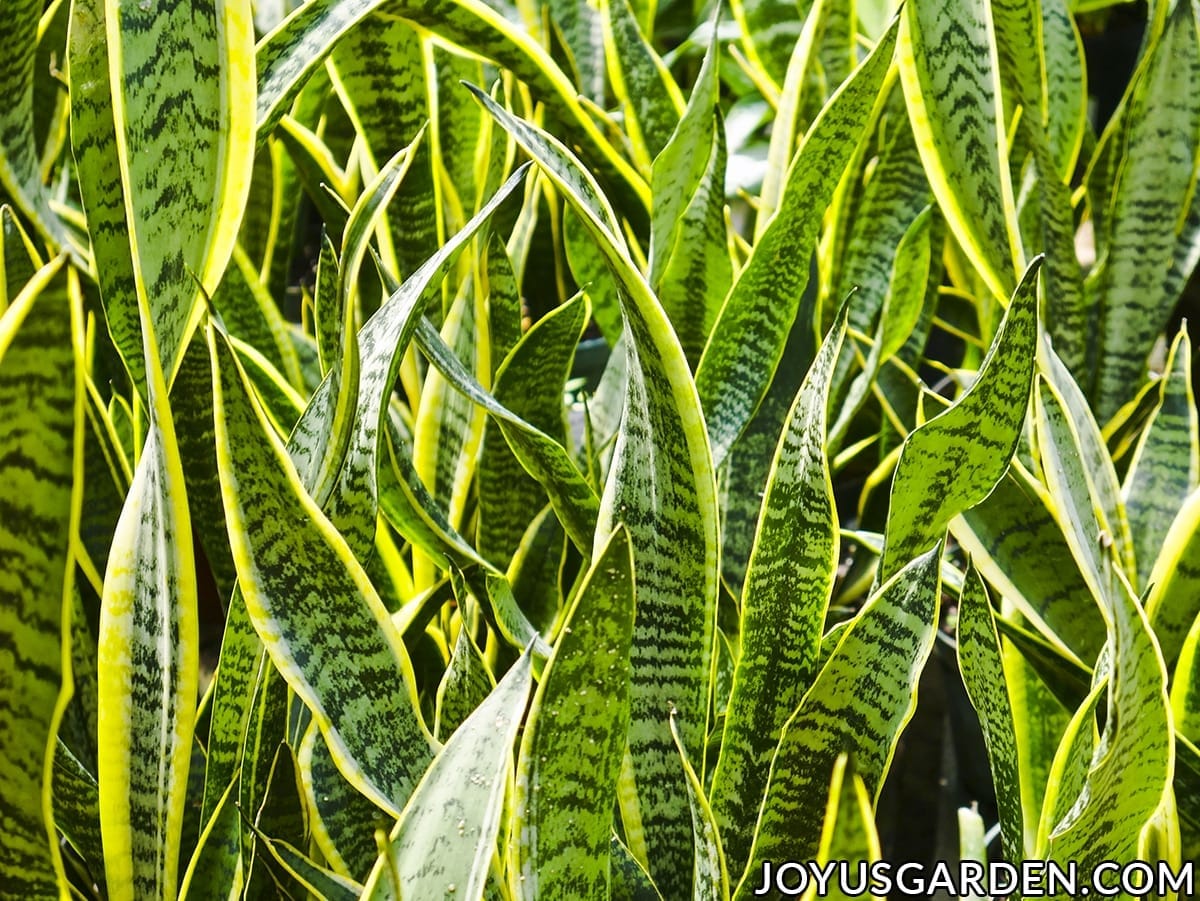
Are you a beginning houseplant gardener? Be sure to put one or two Sansevieria plants on your want list. You’ll soon find out Snake Plant care is a breeze!
Snake Plants make great office plants because they handle dry air better than most houseplants and don’t need much attention. I’ve seen this hardy plant in long planters at airports and office lobbies, tough environments indeed.
If you’re looking for Snake Plants, a couple that might appeal to you Sansevieria Zeylanica and Sansevieria Laurentii.
To Sum It Up: Snake Plants are virtually indestructible unless you have a heavy hand with the watering can or place them in a hot, sunny window. They seem to thrive on the dry air in our homes and neglect. The more you ignore them, the better they seem to do.
I love Snake Plants because of their bold, architectural, sassy look. There are so many species and varieties to choose from. You’ll be hooked too!
Happy gardening,


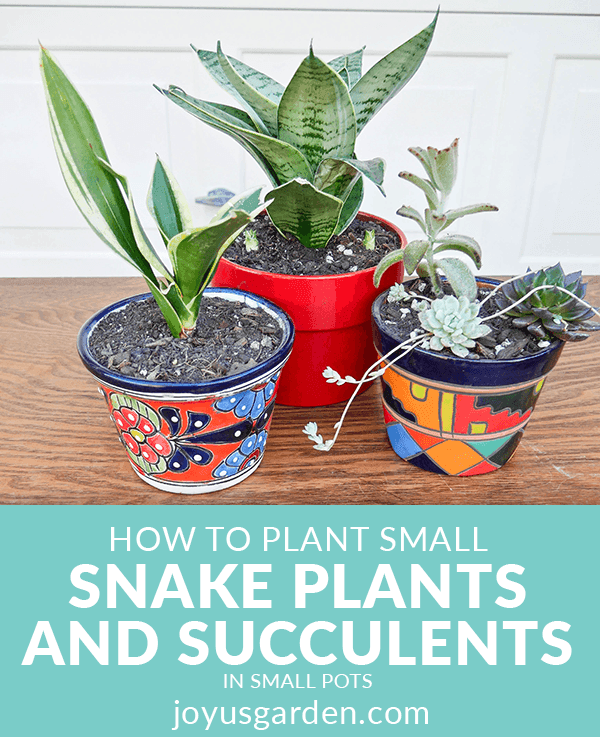
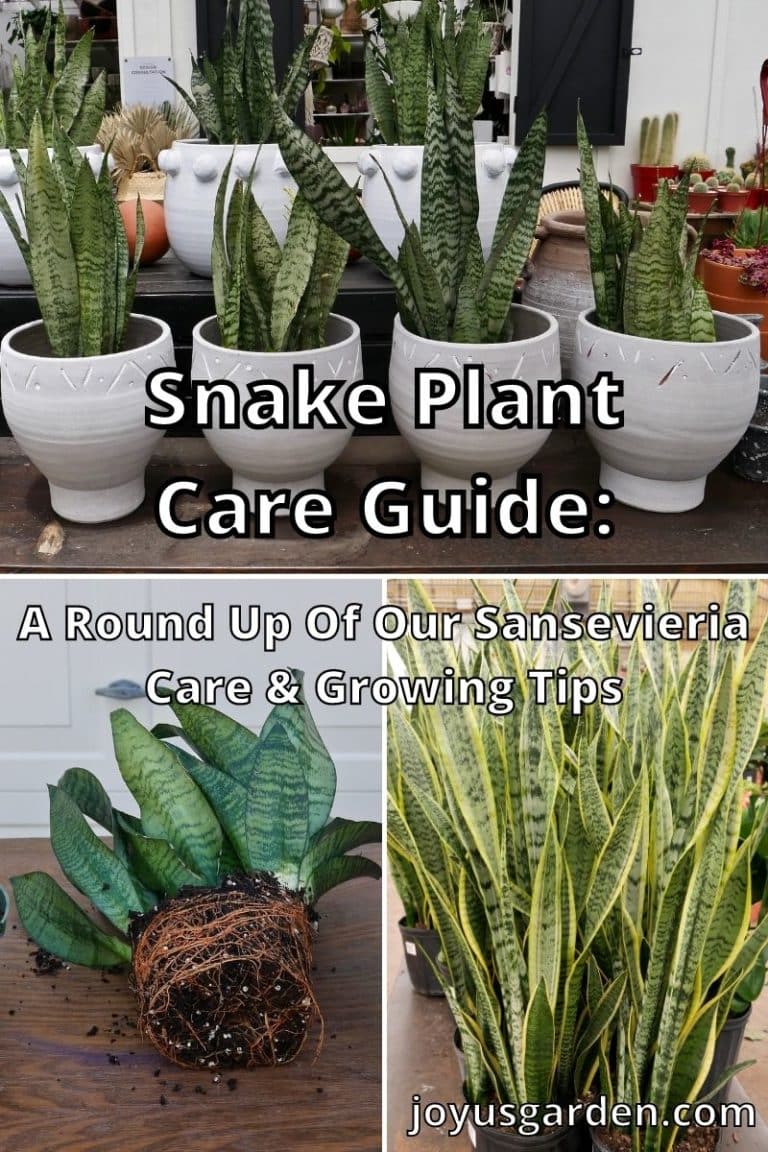
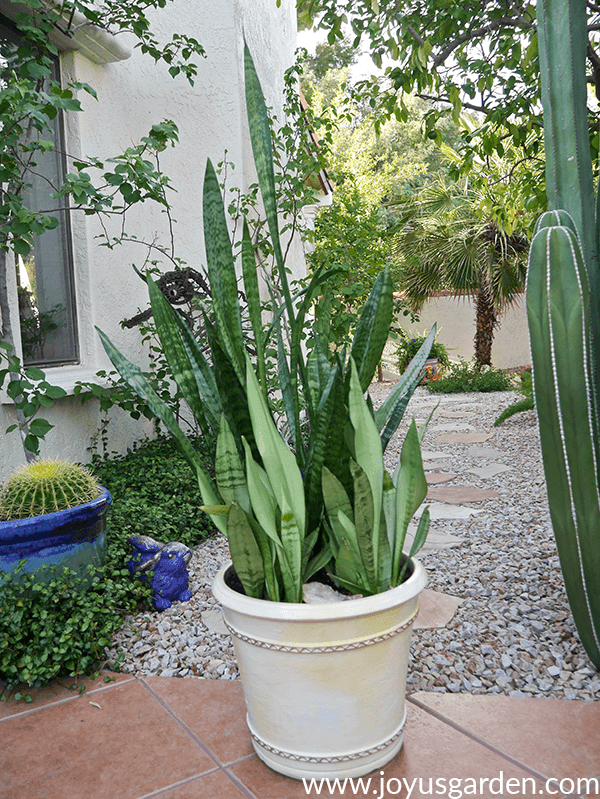
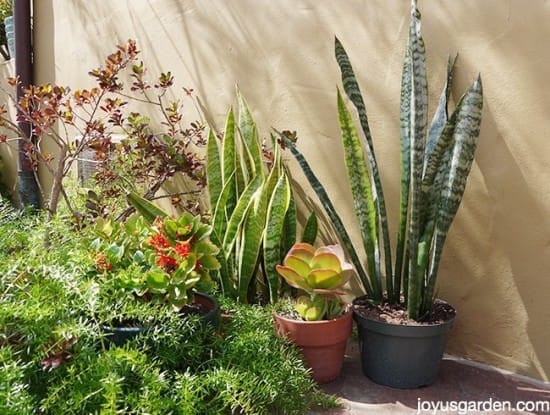
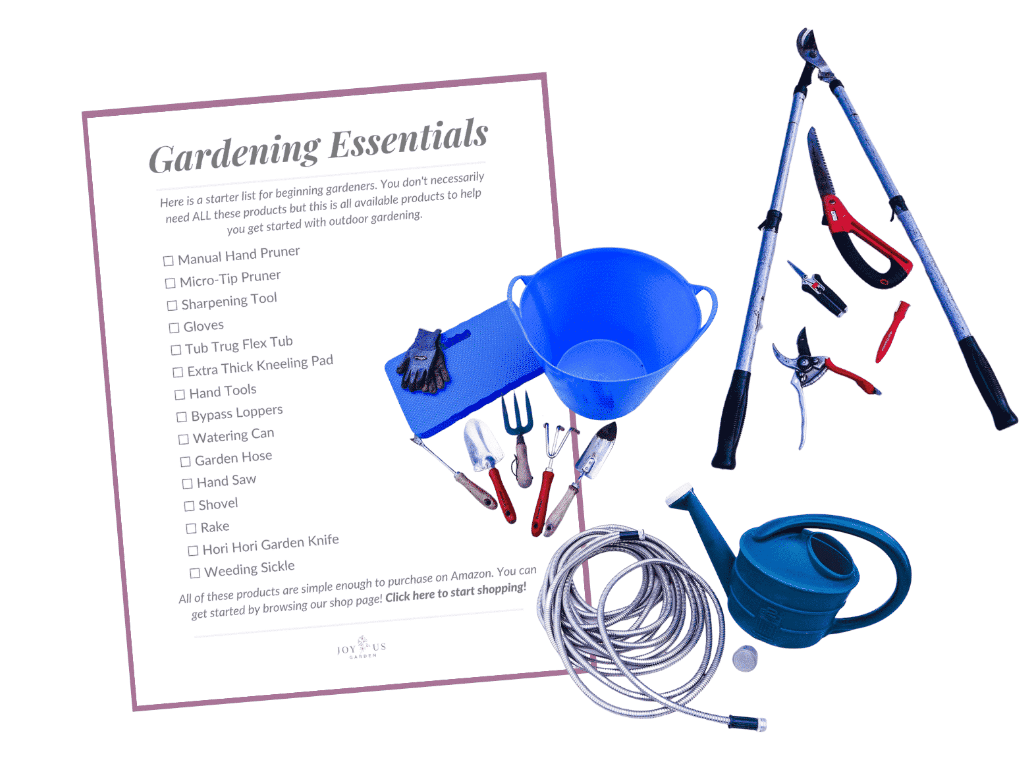
hi , I love the plant it is cool I live in saudi aurbia and man it is hot my plant will die if I put them out in the sun but snake plant can take the heat if you give them the right amount of water thank you .
That is so true! I now live in the southern Arizona desert & quite a few of my Sansevierias live outdoors. I have them in bright shade & water them more than the ones indoors. Nell
Hi,
Delightful plant. I was gone from my home for almost five months. I came home to discover that the black coral sansevieria was alive and thriving. Now, I’ve acquired another. I am eager to grow several different ones.
Hi Frances – I totally agree. I travel a lot through out the year & my Sansies look great too. There are a few other varieties I have my eye on so I’ll definitely be growing more too. Nell
Hello, I live east of Tampa, Fl. and my sansevieria thrives. As a matter of fact I have quite a bit over 4 ft tall. They get about 5-6 hours of sun everyday and regular watering. I don’t fertilize them and they just keep spreading. A person could not ask for a better self sustaining plant.
Terry, I live in a totally different climate than you – the Arizona desert. My Sansevierias are all doing great in this very dry climate. Proof that this is 1 tough yet versatile plant. Thanks for sharing! Nell
Hi Terry,
Thanks for the good info! I like Sansies too and still remember one my grandma had in her living room. It could still be alive 40 years later …!
I hope mine will survive the re-potting I did a couple of months ago. I’m not sure if the soil is too shallow or what, but one leaf turned that icky yellow-brown and I was able to pull it off this week. I think I watered when I put them in the new pot. They also seem to be really loose in the soil, should I pack more in there?
On the happy side, I have a friend who claims a “brown thumb” … I gave her a sansevieria for a house-warming gift and two years later, it’s still going strong … probably because they “thrive on neglect”!
Hi – I always keep Snake Plants dry for a few days after planting to let them settle in. Here in the Arizona desert, I water them every 3 weeks. They do thrive on neglect! Yes, you can pack in more soil but just make sure it’s a light, readily draining mix. I’ve occasionally had to temporarily stake up a heavy Sansie leaf which was falling over in the pot. Nell
I am planning to get one of these plants for my office. My office does not have any windows though, would this plant make it?
Hi Rosalinda – It’ll do fine for a while but not for the long haul. Plants need certain amounts & ratios of artificial light (blue light & red light) which office lighting doesn’t provide. If you give it a go, keep it on the dry side. Nell
I am so glad to have found your website! I just got into houseplants last year, and you are a GOLDMINE of information!!!! Thank you so much for these helpful, instructive, comprehensive posts!!!
Sarah – I’m glad you found our site too! Be sure to check back because I have a lot more houseplant posts planned for this year. Nell
Hi Nell,
I love to see the snake plant get deserved attention, so reading your blog post about them has been a treat. I do have a question about my laurentii. I brought it home in May from the nursery. I suspected the soil was all wrong for it because the thing didn’t dry out until September when I watered it. I have only watered it that once since May, but it appears to have signs of root rot. Some leaves are quite mushy and falling over. Can root rot be caused by not overwatering as far as frequency is concerned, but by having the plant in the wrong soil that holds water too long?
Hi Michele – Yes, root rot can certainly be caused by a mix which is too heavy. Snake Plants need excellent drainage so I always work a lot of succulent & cactus mix into the potting soil when I plant. You can always cut the mushy parts off of the leaves & propagate the non impacted portions. Nell
I’m hoping you can help Nell!
I have a Sansevieria that I’ve had for 30 years and it’s over 5 feet tall, my Mom started it for me…It had been doing so well and it has flowered for me many times…It’s not the one with yellow margins it’s more of a dark green with somewhat lighter strips across…It is always indoors.
I think I may have made a boo boo though…I think I’ve accidentally over watered it lately and some of the leaves have started to turn a pale yellow…I don’t know what I was thinking…I usually ignore it and water it maybe once a month or every 6 weeks and only a little bit…Will it come back? I have had to remove a few leaves…I have a fan blowing on the soil to try and dry it out…I will be heart broken if I lose it…
I am in Winnipeg, Manitoba, Canada
Oh dear Mo. The good news is that Snake Plants are tough. You can transplant it into a fresh fast draining mix (even at this time of year) & see if it recovers. If not, cut the entire plant back & new growth should start appearing from the rhizomes. Nell
Nell,
I just realized that mine looks like the one in your first picture in the beautiful yellow pot…
Hi Mo – Mine is Sansevieria trifasciata Black Coral. Nell
Hi! Thanks for the great information. I just acquired a snake plant from my mother who split a large one of hers to share with me. I did not know it needed water so infrequently and have been watering it weekly. I’ve lost a couple of leaves which turned mushy brown. My question is, some of the larger ones are leaning over, they won’t stay up. What should I do? Maybe the soil is wrong? My mom used regular potting soil.
Hi Courtney – I always use approximately 1/2 potting soil & 1/2 succulent & cactus mix when repotting Snake Plants. You want to avoid any chances of root rot. Often the taller leaves will bend as they grow due to weight. Yours are probably due to too much water. If you want, cut those leaves off, let them heal & then replant into the pot. It might be best to change the mix your using. Nell
Hello from the shores of Georgian Bay Ontario Canada …. minus 25c and up to plus 30 C in the summer at times … I’m way up north … looked for these for a while .. one I had died .. .I think I loved it too much ……now Ive got two big potted ones and a smaller one .. and i’m afraid to water … I love them … love lots of plants. .. and been told I have a green thumb .. I have orchids .. etc …. so I’m hoping these new babies …. hold on .. and I will try to neglect them so far … they are doing well … good information here … especially fertilizing ….. how much water should I apply when I do ? … My house is humid at times …. and I keep the heat at 68 F…… so I truly hope … all goes well … you said about 10 feet away from windows? one is in the front window behind other plants .. it faces ne and one in the back facing w … and about 10 feet away …. another wee one … seems to be doing good …
Hugs from the shores of Georgian Bay Ontario Canada … in a little place called Port McNicoll
Linda
Hi Linda – I water my Snake Plants in the warmer months until it runs out the bottom. In the winter months I water less often & a lesser amount. They’ll burn in direct, hot sun so in a west or south window isn’t good. Mine thrive in low to medium light so they’re great for rooms that don’t have optimum light. The lower the light, the less often you water them. Nell
Thanks so much for your information on snake plants. I love their spicy look, how they filter the air we breath, and most of all they are low maintenance. I will be purchasing my very first one soon. I want them in every room. Thanks for sharing.
Hi AJ – I’m so happy to share because I love them too. I live in the desert (talk about dry!) & they always look good & require very little water. I have my eye out for a few more but I’m trying to find varieties I don’t already have. Nell
Hi! Thanks for the useful information. I have a snake plant that I bought a few months ago. She’s very happy and started to grow baby plants along the rim of the pot. Should I remove these two babies and put them in their own pot? Thanks in advanced.
Hi Yazzi – You can remove them if they have enough roots forming. If they do, it’s your call. Snake Plants actually prefer to grow slightly tight in their pots & on the pot bound side so I don’t transplant mine too often. Nell
Hello! I just got a new snake plant, and I need to repot it out of the ugly plastic nursery pot. Your article mentions a mix of succulent and regular potting mix works best. Do you mix it at 50/50, or another ratio? I’m brand new to houseplants and don’t want to mess this up. Thanks!
Hi Kelsey – I use a more potting soil than succulent & cactus mix. Here’s a post & video I did for your reference: https://www.joyusgarden.com/repotting-snake-plants/ One important thing – don’t water them too often! Nell
Hi Nell, thank you so much for sharing! I’m real excited about my first snake plant, especially because so many plants had died under my care in less than 2 weeks. I’ve no idea why… Insufficient sunlight? Too much sunlight? Too much water? Too much fertilizer? I’m so sad… I love plants but why don’t they ever survive with me? Sigh… 1) I would like to know how often do you need to change the soil of the snake plant? My friend told me I should replace the soil every 6 months. Is that true? 2) Will organic soil do? 3) Is it absolutely necessary to fertilize the snake plant? How much fertilizer to use? I don’t want to kill another plant again! Please help!!!!,
Hi Stephanie – I always use organic soil / mix for all my plants. Snake Plants are scrappy & don’t need to be repotted every 6 months. In fact, they do better slightly potbound. You don’t need to fertilize a SP but you can read what I use in the post under “Fertilizer”. Hope that helps! Nell
Hello Nell! I have lots of Sansevierias planted on the ground and they are really easy to care for. With our tropical climate, I only water them in summer when there’s no rain for a week or two. I transferred 3 pots inside the living room last year and they all had rot spots on random leaves. I watered them once a week then. Should have waited a bit more before watering. I just moved in again some of the pretty potted ones indoors and will definitely take in your advice. I just love how they look and knowing that they purify the air makes me want to get more inside the house! Maayong adlaw from Agusan del Norte, Philippines!
Hello Gloriane & greetings from Arizona! I’ve grown Sansevierias both inside & out. Even here in the Arizona desert I water my snake plants every 3 weeks. Especially if they’re potted in potting soil rather than succulent & cactus mix (I do mine 1/2 & 1/2) you don’t want to water them too often. I love the look of them too! Nell
I was just given one of these Sansevieria plants recently, by a friend, who is giving up, and I was looking for care instructions. Thank you for the very informative and clear video. I feel that I need to look no further. I think that they will like it up here in the City of Terrace, West Coast British Columbia, Canada (just south of Alaska). I grow all tropicals outside from May to October and bring them into a non-freeze greenhouse or our home sunroom for the freezing months. People are a little surprised to see palm trees and Brugmansia growing here, but it’s so much fun to have the Hawaii feeling in our extreme northern climate. I think I will be able to make the Sansevieria a nice home. Well done, Nell.
Thank you so much Avenir! I now live in Arizona but grew up in New England. My dad built a greenhouse off our dining room so we had the “tropical plant effect” all winter long too. I’ve lived in NYC, San Francisco & Santa Barbara. Snake Plants have done extremely well in all those different environs & a couple have made the move with me. I love them here in Tucson because they don’t need as frequent watering as other houseplants do here. Nell
Hey Nell – I have a moonshine sansevieria and just found a sticky brown spot on one of the leaves. Can you tell me what caused it and how to treat the plant? It’s defin thriving because I see new growth. Please let me know!
Hi Diana – It’s hard to say without seeing it. Here are 3 things it could be: a bacteria, fungus or scale. You can do some research & see which looks like what is on the leaf. Nell
I have one that was propagated from one my mom had since before I was born. Seriously, this thing has been in my family with its own little babies for almost 40 years. It’s gotten almost 5 feet tall, so I must be doing something right!
Hi Patty – I said they’re diehard but yours really is proof of that! 5′ tall is impressive for a Snake Plant so you are doing something right. Thanks so much for sharing this. Now others can see how long live they are. Nell
Hi Nell, I’ve had my plant for over 5 years now (I’m great at neglecting it!) and a few of the tall leaves are bending over. Should I cut them and if so, how low should I go? Thanks!
Hi Heather – That happens as the plant ages & grows taller. The leaves can get heavier at the top than the base. It’s happened to me many times. Cut the leaves all the way down to the soil line. You can them propagate that leaf. Nell
Good afternoon from a previous Arizona resident ! I have had the mother-in-law plant for a long time.
I see no growth. It’s healthy, but, again, no growth. What should I try?
Hi Carole – It depends on what level of light you have it in. Plants in lower light grow slower. Sometimes when plants get oder, their growth rate can slow. Although SPs like being tight in their pots, being too potbound will slow growth. Those are just a few of the most common reasons. Nell
mine doesn’t look like that and half of it looks like it’s trying to escape by growing sideways over the edge of the pot. from what i read one cup of water each week is too much. 2/3 of the plant just came out of the ground and fell over when i first got it.
i’ve had the “mother-in-law’s tongue plants and they grew straight up.
Hi Ogn – Sounds like too much water. I water mine every 3 weeks, maybe every 4 in the winter. I just did a post & video on an occasional leaf falling over which you might find helpful: https://www.joyusgarden.com/snake-plant-leaves-falling-over/ Nell
Hello and thank you for this article,
A few months back I’ve surely overwatered my snakeplants on multiple occasions, and right now they still haven’t fully recovered. Apart from the brown spots on their leaves, areas were their leaves interwine seem to have rotten and it doesn’t heal. It also stoppen the new sprout from growing. Below is an image (the adult plants have a similar problem on the tips of the small leaves from
Hi Bogdan – You’re very welcome. Once Snake Plants, or any houseplants for that matter, get repeatedly over watered it’s hard to bring them back. The rot won’t heal by the way. It looks like there a whitish substance near the base but it’s hard to tell from the pic. Could be mealy bugs. If you’d like, cut the plants back & transplant the rhizomes & roots into fresh succulent & cactus mix. New growth will eventually appear. Nell
on the small leaves from the middle of their buquet.
Any ideas on how to heal them?
Thanks
Images:
https://imgur.com/a/cHaZGCB
What a nice website! I love Snake Plants too. I’ve had two of them for 8 years or so and they have always been easy to care for. They are about 2 1/2 feet high now and have always looked great. But they have such extremely shallow roots that when I picked up the pots recently to take them to the sink and water them (which I do about once a month), the plants toppled right out of the pots. I’ve divided them and am trying to repot them, but am not sure how to encourage at least slightly more root growth? I watched your video about repotting snake plants and the rhizomes and root ball on yours is much deeper than on my plants, probably 3 times as big! Also, I’ve seen people say that they should be in low, wide pots, but the roots on mine will not hold the tall plants up in that kind of pot. Another website suggested tall thin pots? Temporarily I have put the new divisions in one gallon pots, with the soil filling only about 3/4 of the pot so there are pot sides to help hold the plant up. I have had to stake them and put rocks on top of the soil to try to hold the plants in. Any advice?
Hi Martha – I’ve grown Snake Plants in all types & sizes of pots. The rhizomes are shallow & the roots don’t go down too terribly deep. Make sure the soil is holding the leaves up. Also, it could be over or under watering. Nell
Just a warning forolder folks or those with thinner skin. The pointed ends of these plants can be very dangerous! I reached into the center of mine to remove some dead leaves, and one of the points tore a large patch of skin from my forearm. Lots of stitches later, I wear long sleeves and gloves to clean mine out now!
Kathy – Thanks for the warning! Some of the pointed tips on the older ones are quite sharp. Nell
New to plants, and just purchased a Laurentii. I was a little nervous because I’m horrible with plants but after this article, I feel much more confident. Thanks!
Jonathan – You’re very welcome! Remember, easy on the watering. Nell
My snake plant is at least 35 years old, with some leaves 4′ tall. It has bloomed many times and I am always amazed by the flower’s beautiful scent.
I recently needed to repot it, as it was just too big and ungainly. I broke it up into 7 new plants. I wanted to let them summer outdoors. I live in the northeast and deer are a big problem. Will they eat the snake plants, or might I be lucky enough that they are deer resistant? Here’s hoping!
Gerri – I don’t know about that. I grow a couple of snake plants outdoors year-round but I don’t live in an area where deer are an issue. Snake Plants are typically grown as houseplants so I’m not sure if you’ll find concrete info on that. Good luck! Nell
Hello everyone after looking through sites to leave my reply on temperatures, I found this one.
I wanted everyone to know that your snake plants can thrive in excess of 100 degree weather! I kid you not! My window glass magnifies the 2pm-6pm sunlight and the windowsill was getting to 140°F ! (Room temperature was around 90°F. (This is on 2 different hygrometer measurements so it’s accurate.
The cuttings of mine actually flourished in the extreme heat! For my own enjoyment of my room I ran 2 fans and recently installed a bamboo patio cover to block half the light now the windowsill is 80-88°F and the room is about 75-80°F at this halfway point of spring.
Again I just want to say snake plants are really an enduring plant! They can take an extremely high temperature. Every now and then you just want to throughly drench them and let the excess water drain out. Otherwise for my 10 inch pot plants I just give then 1 ¾ cup of water every week or so.
What is the yellow-leaved snake plant in the “babies” pic near the top? It’s so pretty!